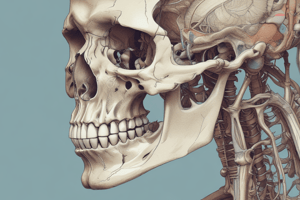Podcast
Questions and Answers
What is the primary function of the skeletal system?
What is the primary function of the skeletal system?
- to produce blood cells
- to aid in digestion
- to regulate body temperature
- to provide movement (correct)
Which type of bone is characterized by being longer than it is wide?
Which type of bone is characterized by being longer than it is wide?
- long bone (correct)
- short bone
- irregular bone
- flat bone
What is the function of articular cartilage in synovial joints?
What is the function of articular cartilage in synovial joints?
- to restrict movement of the joint
- to allow for smooth, pain-free movement (correct)
- to produce synovial fluid
- to hold the bones together
Which type of synovial joint allows movement through three planes?
Which type of synovial joint allows movement through three planes?
What is the term for the movement of bending a joint, such as in a bicep curl?
What is the term for the movement of bending a joint, such as in a bicep curl?
Which type of bone is embedded in tendons and protects them from wear and tear?
Which type of bone is embedded in tendons and protects them from wear and tear?
What is the term for the movement of turning the upper body or head towards one side?
What is the term for the movement of turning the upper body or head towards one side?
Which direction is described as 'away from the middle of the body'?
Which direction is described as 'away from the middle of the body'?
What is the term for the movement of the toes lifting upward?
What is the term for the movement of the toes lifting upward?
Which type of muscle contraction occurs when the muscle exerts force and shortens in length?
Which type of muscle contraction occurs when the muscle exerts force and shortens in length?
What is the role of the antagonist muscle in a movement?
What is the role of the antagonist muscle in a movement?
What is the function of the respiratory system?
What is the function of the respiratory system?
During a bicep curl, what type of muscle contraction occurs in the bicep muscle?
During a bicep curl, what type of muscle contraction occurs in the bicep muscle?
What is the term for the joint action that occurs during a bicep curl?
What is the term for the joint action that occurs during a bicep curl?
What is the site of external gas exchange in the respiratory system?
What is the site of external gas exchange in the respiratory system?
What is the term for the muscle that provides power for a movement?
What is the term for the muscle that provides power for a movement?
Study Notes
Skeletal System Functions
- Provides structure to the body
- Allows for movement
- Protects vital organs
- Produces blood cells
- Stores minerals
- Regulates endocrine functions
Anatomical Directions
- Superior: above
- Inferior: below
- Anterior: front
- Posterior: back
Types of Bones
- Long bones: longer than wide, support weight, examples: humerus, ulna, radius
- Short bones: as wide as long, provide limited movement, examples: carpals, tarsals
- Flat bones: flattened surface, very little movement, protect vital organs, examples: costals, skulls, sternum
- Irregular bones: very limited movement, protect vital organs, examples: mandible, coccyx, sacrum
- Sesamoid bones: embedded in tendons, protect tendons from wear and tear, example: patella
Synovial Joints
- Only joints that allow for free movement
- Provide movement and stability
- Types of synovial joints:
- Plane joints (inter-tarsal joints)
- Hinge joints (elbow) - allow movement along one axis for flexion or extension
- Ball-and-socket joints (hip) - allow movement through three planes (flexion, extension; abduction, adduction; rotation)
Internal Structure of Synovial Joints
- Articular cartilage: allows for smooth pain-free movement
- Synovial membrane and joint cavity: hold synovial fluid, provide lubricant for joint movement
- Ligaments: hold bones together, restrict movement to joint type
Joint Actions
- Flexion: decrease angle between bones, example: bicep curl
- Extension: increase angle between bones, example: bicep curl
- Abduction: movement away from body's midline, example: lateral raises
- Adduction: movement towards body's midline, example: lateral rises
- Rotation: turning upper body/head towards one side, example: stretching
- Circumduction: rotation with circular motion of a limb, example: bowling
- Plantar flexion: toes point forward, example: stepping on accelerator
- Dorsiflexion: toes lifted upward, example: taking foot off accelerator
Muscular System
- Provides or causes movement
- Agonist: provides power for movement, example: bicep in bicep curl
- Antagonist: supports agonist, example: tricep in bicep curl
- Muscle contractions:
- Concentric: muscle exerts force, shortens in length, example: bicep curl up
- Eccentric: muscle produces force, increases in length, example: bicep curl down
- Isometric: muscle produces force, no change in length, example: plank
Respiratory System
- Functions: inspire oxygen, expire carbon dioxide, promote gas exchange
- Enables respiration (transfer of gases between blood and lungs)
- Internal gas exchange: oxygenated blood delivers oxygen, clears CO2 in muscles
- External gas exchange: alveoli, Deo2 blood delivers CO2, picks up O2
- Components:
- Nasal cavity: warms air
- Pharynx: combines nasal and oral cavity, allows for air, food, and liquid movement
- Larynx: voice box
- Trachea: main air pipe, splits into 2 bronchi
Studying That Suits You
Use AI to generate personalized quizzes and flashcards to suit your learning preferences.
Description
This quiz covers the main functions of the skeletal system, including providing structure, allowing for movement, and protecting vital organs. It also explores the different types of bones, including long, short, and flat bones, and their characteristics.




